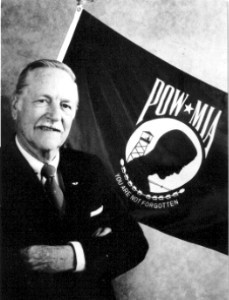 on Okinawa and that the 623rd Association was still "in business." I vowed to tell them of my experience with your organization!
on Okinawa and that the 623rd Association was still "in business." I vowed to tell them of my experience with your organization!
During WWII I was flying for Troop Carrier in the South Pacific, a brand new 1st Lieutenant at the time. This was just when we first occupied Japan and I was in route to Tachikawa Air Base where I was stationed. Two hours from Japan we were socked-in, zero visibility. I guess it was one hour when I called for a GPA 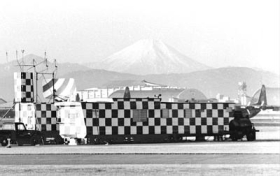 approach (my first experience with this) and was recognized by the radar unit. Following their instructions to the letter, I knew the operator spotted me and felt better for that, I can assure you! I was flying a C-46, by the way.
approach (my first experience with this) and was recognized by the radar unit. Following their instructions to the letter, I knew the operator spotted me and felt better for that, I can assure you! I was flying a C-46, by the way.
Finally your operator got me on the final approach and I shall never forget his last words to me: "You are now 14 feet over the end of the runway, cut your engines! Talk about a remarkable performance on the part of that operator!
To this day I regret not finding out where he was and giving him my hearty congratulations plus a hug for his guiding me down! I hope you know how extremely thankful I was (and my crew)!
It's high time, sixty years later, that I made my thoughts known!!
Several months before this occurred, and the war still on, I was parked at Naha for a one-night-stand. I was flopped on the sand for what I hoped to be a good night’s sleep 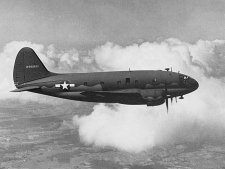 when I heard the drone of an airplane above me. The searchlights went on, then were extinguished so I thought 'it's a friendly' and settled back on the beach. Not for long! That plane was headed right for me in a power dive with engines screaming! Already on the deck I wanted to be below it!
when I heard the drone of an airplane above me. The searchlights went on, then were extinguished so I thought 'it's a friendly' and settled back on the beach. Not for long! That plane was headed right for me in a power dive with engines screaming! Already on the deck I wanted to be below it!
The "Kamikaze" missed me and struck the wing of the plane beside me. Fortunately the crew was sleeping under the right wing and he slammed into the left. Just tipped it, otherwise there would have been a huge and perhaps a spreading fire. That was about all the sleep I got that night in Naha!
In 1970 I was privileged to design the POW-MIA Flag for our country. It was flying The South Pacific Ocean that I came up with the words on that flag "You are Not Forgotten." I think it has come true. Those veterans of all wars should be remembered always!!
Most sincerely, to the 623rd!
~ Newt Heisley
Dear Newt;
Your letter moved me deeply. I’ve often thought for many of us, our experience in the military was so 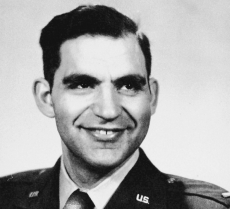 intense that everything after seemed a kind of anti-climax. I’ve had experiences similar to yours. Not quite as dramatic as having a zero exploding a few yards away from my airplane, but close enough. Among other things, I am a private pilot, and have a good deal of appreciation for your story. I am also familiar with Tachikawa. I Flew from there often. And I know some of the radar operators in that tower.
intense that everything after seemed a kind of anti-climax. I’ve had experiences similar to yours. Not quite as dramatic as having a zero exploding a few yards away from my airplane, but close enough. Among other things, I am a private pilot, and have a good deal of appreciation for your story. I am also familiar with Tachikawa. I Flew from there often. And I know some of the radar operators in that tower.
I’ll tell you a story about one of them. He was a warm and outgoing person, though he enjoyed letting others see him as a cynic. His name was Al Tanenbaum. One day while I was on TDY at Itazuke, I read that he had received a medal. I forget the phrasing, but it was basically for competence of an extremely high order during an emergency.
I was curious as to what he did to deserve it. The next time I was in Tachikawa, I asked him. This was the incident:
It was a very bad night, the whole area socked in, and as bad luck had it, a whole stream of aircraft were coming in from several directions and had to be landed. This was during the Korean War. ILS procedures had not been changed significantly since WWII. They still had to be talked in, and they were still being stacked up in holding patterns. Al was off duty, but something drew him to the tower.
A new and inexperienced operator had been assigned to the radars, and he was having trouble. There were a great many planes stacked up, nine if memory serves, and as you know, they had to be brought in one at a time, the lowest first; everybody descends one slot, etc. Tough enough, but it got much worse. The pilot at the top of the heap declared a “Mayday.” He had to be brought down through the stack, out of turn. The operator froze.
Al pulled the operator out of the chair, gave the circling aircraft emergency vectors, and brought the crippled ship in safely. A remarkable performance.
Al, I said, how did you become such a cool cookie? Tell me your secret.
He was embarrassed at getting the medal, and brushed me off at first, but I persisted. He said: “when there is an emergency, I tell myself, no matter what, I’m in the tower, and the tower is not going to crash.”
Years later, back in the states, I told that story to my wife. It became a sort of private code. Whenever something disturbing happened, we would tell one another: stay calm now. Remember the tower is not going to crash.
I am going to pass your letter on to other members of the 623rd. Let them know that they are still appreciated. Let them enjoy it as much as I did.
Thank you again. And stay well.
All best – Howard Singer
Howard Singer is an U.S.A.F. Veteran and author of the book "Wake me when it's over" which was produced as a movie starring Ernie Kovacs. Mr. Singer is a member of the 623rd AC&W Reunion Association.
About Newt Heisley -
Newt Heisley was a pilot during World War II, a dangerous role that accounts for many war-time POWs and MIAs. Years after the war he had come to New York looking for work. "It took me four days to find a bad job at low pay," he later said of his introduction to "Big Apple" advertising agencies. But, by working hard, by 1971 he had gradually moved upward in the industry, eventually working for an agency with many national accounts.
As a veteran, the call for a flag designed to raise awareness of our Nation's POW/MIAs was a personal challenge. It was even more challenging when he considered that his oldest son Jeffrey was, during these Vietnam War years, training for combat with the United States Marines at Quantico, Virginia. As he pondered this new challenge a series of events set in motion the ideas that would create a flag unlike anything since the days of Betsy Ross. First, Jeffery became very ill while training for combat. The illness, diagnosed as hepatitis, ravaged his body emaciating his face and structure. When he returned home, medically discharged and unable to continue further, his father looked in horror at what had once been a strong, young man. Then, as Newt Heisley looked closer at his son's gaunt features, he began to imagine what life must be like for those behind barbed wire fences on foreign shores. Slowly he began to sketch the profile of his son, working in pencil to create a black and white silhouette, as the new flag's design was created in his mind. Barbed wire, a tower, and most prominently the visage of a gaunt young man became the initial proposal.
Newt Heisley's black and white pencil sketch was one of several designs considered for the new POW/MIA flag. Newt planned, should his design be accepted, to add color at a later date...perhaps a deep purple and white. 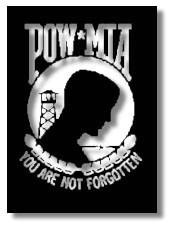 "In the advertising industry, you do everything in black and white first, then add the color," he says. Mr. Heisley's proposal for the new flag was unique. Rarely does a flag prominently display the likeness of a person. None-the-less, it was the design featuring the gaunt silhouette of his son Jeffrey that was accepted and, before Mr. Heisly could return to refine his proposal and add the colors he had planned, the black and white flags were already being printed in quantity by Annon & Company. (Though the POW/MIA flag has been produced in other colors, often in red and white, the black and white design became the most commonly used version.)
"In the advertising industry, you do everything in black and white first, then add the color," he says. Mr. Heisley's proposal for the new flag was unique. Rarely does a flag prominently display the likeness of a person. None-the-less, it was the design featuring the gaunt silhouette of his son Jeffrey that was accepted and, before Mr. Heisly could return to refine his proposal and add the colors he had planned, the black and white flags were already being printed in quantity by Annon & Company. (Though the POW/MIA flag has been produced in other colors, often in red and white, the black and white design became the most commonly used version.)
The design for the MIA/POW flag was never copyrighted. It became a flag that belongs to everyone, a design that hauntingly reminds us of those we dare not ever forget. Behind the black and white silhouette is a face we can't see...the face of a husband, a father, or a son who has paid with their freedom, for our freedom.
Beneath the image are the words.... You Are Not Forgotten.
Article suggested by - Fredio Samples Page by J London.